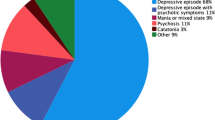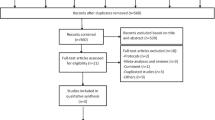Abstract
Purpose
Electroconvulsive therapy (ECT) is effective for treating several psychiatric disorders. However, only a minority of patients are treated with ECT. It is of primary importance to characterize their profile for epidemiological purposes and to inform clinical practice. We aimed to characterize the longitudinal profile of psychopathology and services utilization of patients first treated with ECT.
Methods
We conducted a population-based comparative study using data from a national administrative database in Quebec. Patients who received a first ECT between 2002 and 2016 were compared to controls who were hospitalized in psychiatry but did not receive ECT. We performed descriptive analyses to compare psychiatric diagnoses, domains of psychopathology (internalizing, externalizing and thought/psychotic disorders), medical services and medication use in the 5 years prior to the ECT or hospitalization.
Results
5 080 ECT patients were compared with 179 594 controls. Depressive, anxiety, bipolar and psychotic disorders were more frequent in the ECT group. 96.2% of ECT patients had been diagnosed with depression and 53.8% with a primary psychotic disorder. In the ECT group, 1.0% had been diagnosed exclusively with depression and 47.0% had disorders from that belong to all three domains of psychopathology. Having both internalizing and thought/psychotic disorders was associated with an increased likelihood of receiving ECT vs having internalizing disorders alone (unadjusted OR = 2.93; 95% CI = 2.63, 3.26). All indicators of mental health services utilization showed higher use among ECT patients.
Conclusion
Our results provide robust evidence of complex longitudinal psychopathology and extensive services utilization among ECT patients.

Similar content being viewed by others
Data availability
The data are not available to the public due to confidentiality requirements.
Abbreviations
- ASD:
-
Absolute standardized difference
- CI:
-
Confidence interval
- DSM:
-
Diagnostic and statistical manual
- ECT:
-
Electroconvulsive therapy
- HiTOP:
-
Hierarchical taxonomy of psychopathology
- ICD:
-
International classification of diseases
- INSPQ:
-
Institut national de santé publique du Québec
- OR:
-
Odds ratio
- MDE:
-
Major depressive episode
- QICDSS:
-
Québec integrated chronic disease surveillance system
- TRD:
-
Treatment-resistant depression
References
Blais C, Jean S, Sirois C, Rochette L, Plante C, Larocque I, Doucet M, Ruel G, Simard M, Gamache P (2014) Quebec integrated chronic disease surveillance system (QICDSS), an innovative approach. Chronic Dis Inj Can 34(4):226–235
Abrams R (2002) Electroconvulsive therapy. Oxford University Press
Ionescu DF, Rosenbaum JF, Alpert JE (2015) Pharmacological approaches to the challenge of treatment-resistant depression. Dialogues Clin Neurosci 17(2):111. https://doi.org/10.31887/DCNS.2015.17.2/dionescu
Weiss A, Hussain S, Ng B, Sarma S, Tiller J, Waite S, Loo C (2019) Royal Australian and New Zealand College of Psychiatrists professional practice guidelines for the administration of electroconvulsive therapy. Aust N Z J Psychiatry 53(7):609–623. https://doi.org/10.1177/0004867419839139
Leiknes KA, Schweder LJV, Høie B (2012) Contemporary use and practice of electroconvulsive therapy worldwide. Brain Behavior 2(3):283–344. https://doi.org/10.1002/brb3.37
Kennedy SH, Lam RW, McIntyre RS, Tourjman SV, Bhat V, Blier P, Hasnain M, Jollant F, Levitt AJ, MacQueen GM (2016) Canadian network for mood and anxiety treatments (CANMAT) 2016 clinical guidelines for the management of adults with major depressive disorder: section 3. Pharmacological treatments. Can J Psychiatry 61(9):540–560. https://doi.org/10.1177/0706743716659417
Rush AJ, Trivedi MH, Wisniewski SR, Nierenberg AA, Stewart JW, Warden D, Niederehe G, Thase ME, Lavori PW, Lebowitz BD (2006) Acute and longer-term outcomes in depressed outpatients requiring one or several treatment steps: a STAR* D report. Am J Psychiatry 163(11):1905–1917. https://doi.org/10.1176/ajp.2006.163.11.1905
Lam RW, McIntosh D, Wang J, Enns MW, Kolivakis T, Michalak EE, Sareen J, Song W-Y, Kennedy SH, MacQueen GM (2016) Canadian network for mood and anxiety treatments (CANMAT) 2016 clinical guidelines for the management of adults with major depressive disorder: section 1. Disease burden and principles of care. Can J Psychiatry 61(9):510–523. https://doi.org/10.1177/0706743716659416
Lemasson M, Haesebaert J, Rochette L, Pelletier E, Lesage A, Patry S (2018) Electroconvulsive therapy practice in the Province of Quebec: linked health administrative data study from 1996 to 2013. Can J Psychiatry 63(7):465–473. https://doi.org/10.1177/0706743717738492
Grote NK, Frank E (2003) Difficult-to-treat depression: the role of contexts and comorbidities. Biol Psychiat 53(8):660–670. https://doi.org/10.1016/s0006-3223(03)00006-4
Cailhol L, Pelletier É, Rochette L, Renaud S, Koch M, David P, Villeneuve E, Lunghi C, Lesage A (2021) Utilization of health care services by patients with cluster B personality disorders or Schizophrenia. Psychiatr Serv 72(12):1392–1399. https://doi.org/10.1176/appi.ps.202000554
Huỳnh C, Kisely S, Rochette L, Pelletier É, Jutras-Aswad D, Larocque A, Fleury MJ, Lesage A (2021) Using administrative health data to estimate prevalence and mortality rates of alcohol and other substance-related disorders for surveillance purposes. Drug Alcohol Rev 40(4):662–672. https://doi.org/10.1111/dar.13235
Kotov R, Krueger RF, Watson D, Achenbach TM, Althoff RR, Bagby RM, Brown TA, Carpenter WT, Caspi A, Clark LA (2017) The hierarchical taxonomy of psychopathology (HiTOP): a dimensional alternative to traditional nosologies. J Abnorm Psychol 126(4):454. https://doi.org/10.1037/abn0000258
DeYoung CG, Kotov R, Krueger RF, Cicero DC, Conway CC, Eaton NR, Forbes MK, Hallquist MN, Jonas KG, Latzman RD (2022) Answering questions about the Hierarchical Taxonomy of Psychopathology (HiTOP): analogies to whales and sharks miss the boat. Clin Psychol Sci 10(2):279–284. https://doi.org/10.1177/21677026211049390
Lemasson M, Patry S, Massamba V, Rochette L, Pelletier É, Lesage A (2021) Profil d’utilisation de l’électroconvulsivothérapie chez l’adulte au Québec: mise à jour 2020.
Kotov R, Krueger RF, Watson D, Cicero DC, Conway CC, DeYoung CG, Eaton NR, Forbes MK, Hallquist MN, Latzman RD (2021) The hierarchical taxonomy of psychopathology (HiTOP): a quantitative nosology based on consensus of evidence. Annu Rev Clin Psychol 17:83–108. https://doi.org/10.1146/annurev-clinpsy-081219-093304
Krueger RF, Hobbs KA, Conway CC, Dick DM, Dretsch MN, Eaton NR, Forbes MK, Forbush KT, Keyes KM, Latzman RD (2021) Validity and utility of hierarchical taxonomy of Psychopathology (HiTOP): II externalizing superspectrum. World Psychiatry 20(2):171–193. https://doi.org/10.1002/wps.20844
Pampalon R, Hamel D, Gamache P, Philibert MD, Raymond G, Simpson A (2012) An area-based material and social deprivation index for public health in Québec and Canada. Can J Public Health/Revue Canadienne de Sante’e Publique. https://doi.org/10.1007/BF03403824
Austin PC (2009) Balance diagnostics for comparing the distribution of baseline covariates between treatment groups in propensity-score matched samples. Stat Med 28(25):3083–3107. https://doi.org/10.1002/sim.3697
Kaster TS, Blumberger DM, Gomes T, Sutradhar R, Dasklakis ZJ, Wijeysundera DN, Vigod SN (2020) Patient-level characteristics and inequitable access to inpatient electroconvulsive therapy for depression: a population-based cross-sectional study: caractéristiques au niveau du patient et accès inéquitable à la thérapie électroconvulsive pour patients hospitalisés. Can J Psychiatry. https://doi.org/10.1177/0706743720935647
Caspi A, Moffitt TE (2018) All for one and one for all: mental disorders in one dimension. Am J Psychiatry 175(9):831–844. https://doi.org/10.1176/appi.ajp.2018.17121383
Kellner C, Obbels J, Sienaert P (2019) When to consider electroconvulsive therapy (ECT). Acta Psychiatr Scand. https://doi.org/10.1111/acps.13134
Verona E, Sachs-Ericsson N, Joiner TE Jr (2004) Suicide attempts associated with externalizing psychopathology in an epidemiological sample. Am J Psychiatry 161(3):444–451. https://doi.org/10.1176/appi.ajp.161.3.444
Nordenskjöld A, von Knorring L, Engström I (2012) Predictors of the short-term responder rate of Electroconvulsive therapy in depressive disorders-a population based study. BMC Psychiatry 12(1):1–7. https://doi.org/10.1186/1471-244X-12-115
Yip AG, Ressler KJ, Rodriguez-Villa F, Siddiqi SH, Seiner SJ (2021) Treatment outcomes of electroconvulsive therapy for depressed patients with and without borderline personality disorder: a retrospective cohort study. J Clin Psychiatry. https://doi.org/10.4088/JCP.19m13202
Rönnqvist I, Nilsson FK, Nordenskjöld A (2021) Electroconvulsive therapy and the risk of suicide in hospitalized patients with major depressive disorder. JAMA Netw Open 4(7):e2116589–e2116589. https://doi.org/10.1001/jamanetworkopen.2021.16589
Funding
This research was funded by a grant from FRQS—Partenariat Innovation Québec—Janssen. S.L. and F.G-Z-K. received a grant from the Quebec Network on Suicide, Mood Disorders and Associated Disorders (RQSHA). C.S. is supported by Fonds de recherche du Québec – Santé (Junior 2) salary award.
Author information
Authors and Affiliations
Contributions
All authors contributed to the study design. FG-Z-K, LR and SL: conducted the analyses. SL: drafted the manuscript. All authors contributed to the interpretation of the results, revised the manuscript, and approved the final version.
Corresponding author
Ethics declarations
Conflict of interest
The authors have no competing interests to declare.
Ethical approval
This project was approved by the Ethics committee of both the Institut universitaire en santé mentale de Montréal and of Université Laval. Access to the QICDSS was approved by government bodies, the Public Health Ethics Committee, and the Commission d'accès à l'information du Québec for chronic disease surveillance purposes [1]. Informed consent was not required in the context of register-based studies that use anonymized data. This study was performed in line with the principles of the 1964 Helsinki Declaration.
Supplementary Information
Below is the link to the electronic supplementary material.
Rights and permissions
Springer Nature or its licensor holds exclusive rights to this article under a publishing agreement with the author(s) or other rightsholder(s); author self-archiving of the accepted manuscript version of this article is solely governed by the terms of such publishing agreement and applicable law.
About this article
Cite this article
Lafrenière, S., Gholi-Zadeh-Kharrat, F., Sirois, C. et al. The 5-year longitudinal diagnostic profile and health services utilization of patients treated with electroconvulsive therapy in Quebec: a population-based study. Soc Psychiatry Psychiatr Epidemiol 58, 629–639 (2023). https://doi.org/10.1007/s00127-022-02369-w
Received:
Accepted:
Published:
Issue Date:
DOI: https://doi.org/10.1007/s00127-022-02369-w




